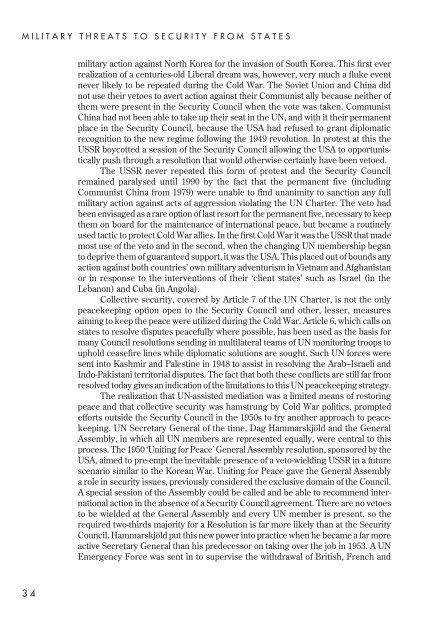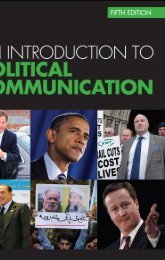Understanding global security - Peter Hough
Understanding global security - Peter Hough
Understanding global security - Peter Hough
Create successful ePaper yourself
Turn your PDF publications into a flip-book with our unique Google optimized e-Paper software.
MILITARY THREATS TO SECURITY FROM STATES<br />
military action against North Korea for the invasion of South Korea. This first ever<br />
realization of a centuries-old Liberal dream was, however, very much a fluke event<br />
never likely to be repeated during the Cold War. The Soviet Union and China did<br />
not use their vetoes to avert action against their Communist ally because neither of<br />
them were present in the Security Council when the vote was taken. Communist<br />
China had not been able to take up their seat in the UN, and with it their permanent<br />
place in the Security Council, because the USA had refused to grant diplomatic<br />
recognition to the new regime following the 1949 revolution. In protest at this the<br />
USSR boycotted a session of the Security Council allowing the USA to opportunistically<br />
push through a resolution that would otherwise certainly have been vetoed.<br />
The USSR never repeated this form of protest and the Security Council<br />
remained paralysed until 1990 by the fact that the permanent five (including<br />
Communist China from 1979) were unable to find unanimity to sanction any full<br />
military action against acts of aggression violating the UN Charter. The veto had<br />
been envisaged as a rare option of last resort for the permanent five, necessary to keep<br />
them on board for the maintenance of international peace, but became a routinely<br />
used tactic to protect Cold War allies. In the first Cold War it was the USSR that made<br />
most use of the veto and in the second, when the changing UN membership began<br />
to deprive them of guaranteed support, it was the USA. This placed out of bounds any<br />
action against both countries’ own military adventurism in Vietnam and Afghanistan<br />
or in response to the interventions of their ‘client states’ such as Israel (in the<br />
Lebanon) and Cuba (in Angola).<br />
Collective <strong>security</strong>, covered by Article 7 of the UN Charter, is not the only<br />
peacekeeping option open to the Security Council and other, lesser, measures<br />
aiming to keep the peace were utilized during the Cold War. Article 6, which calls on<br />
states to resolve disputes peacefully where possible, has been used as the basis for<br />
many Council resolutions sending in multilateral teams of UN monitoring troops to<br />
uphold ceasefire lines while diplomatic solutions are sought. Such UN forces were<br />
sent into Kashmir and Palestine in 1948 to assist in resolving the Arab–Israeli and<br />
Indo-Pakistani territorial disputes. The fact that both these conflicts are still far from<br />
resolved today gives an indication of the limitations to this UN peacekeeping strategy.<br />
The realization that UN-assisted mediation was a limited means of restoring<br />
peace and that collective <strong>security</strong> was hamstrung by Cold War politics, prompted<br />
efforts outside the Security Council in the 1950s to try another approach to peacekeeping.<br />
UN Secretary General of the time, Dag Hammarskjöld and the General<br />
Assembly, in which all UN members are represented equally, were central to this<br />
process. The 1950 ‘Uniting for Peace’ General Assembly resolution, sponsored by the<br />
USA, aimed to pre-empt the inevitable presence of a veto-wielding USSR in a future<br />
scenario similar to the Korean War. Uniting for Peace gave the General Assembly<br />
a role in <strong>security</strong> issues, previously considered the exclusive domain of the Council.<br />
A special session of the Assembly could be called and be able to recommend international<br />
action in the absence of a Security Council agreement. There are no vetoes<br />
to be wielded at the General Assembly and every UN member is present, so the<br />
required two-thirds majority for a Resolution is far more likely than at the Security<br />
Council. Hammarskjöld put this new power into practice when he became a far more<br />
active Secretary General than his predecessor on taking over the job in 1953. A UN<br />
Emergency Force was sent in to supervise the withdrawal of British, French and<br />
34
















